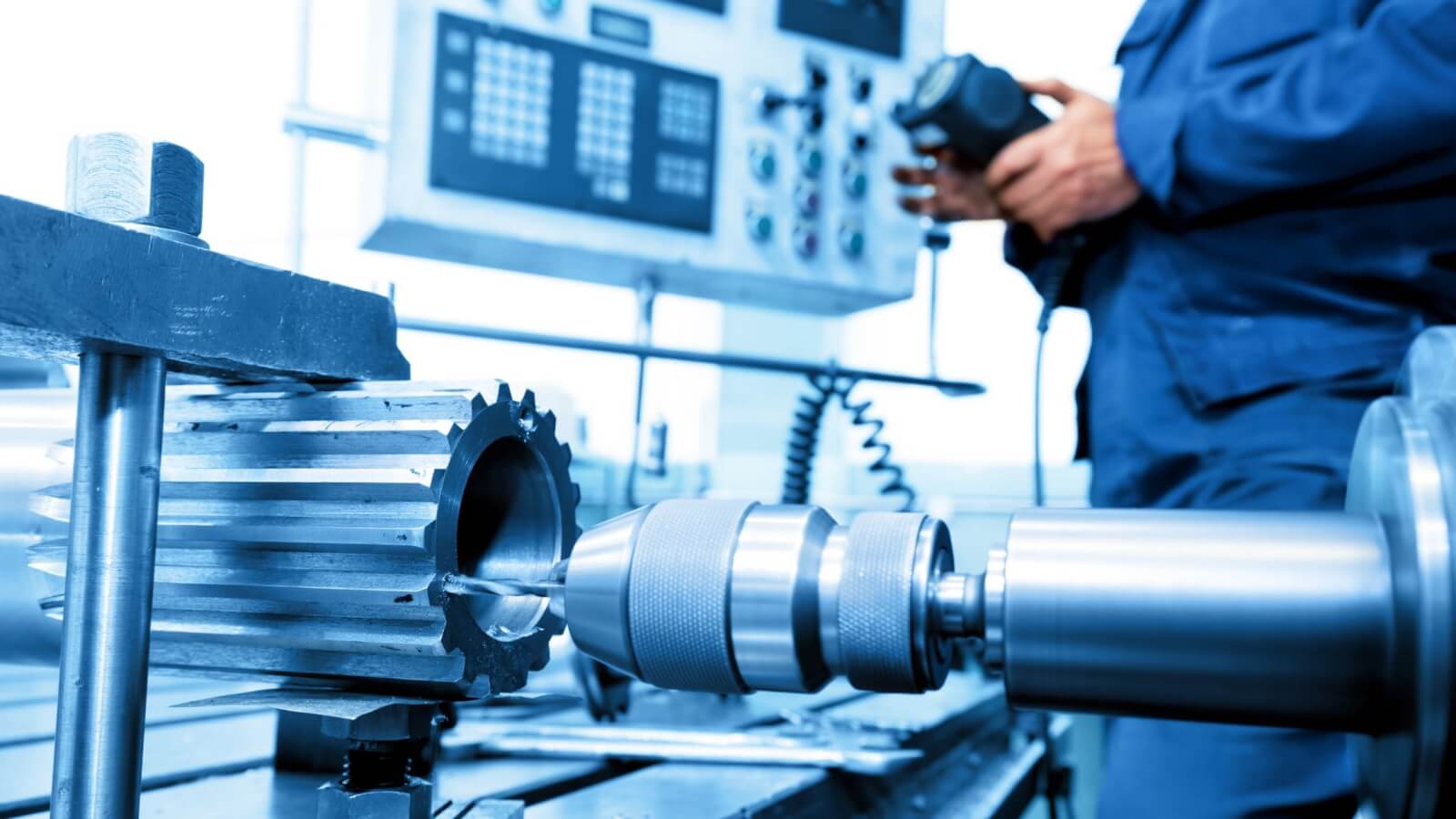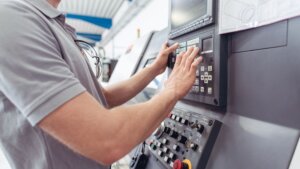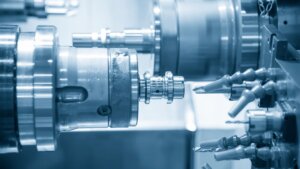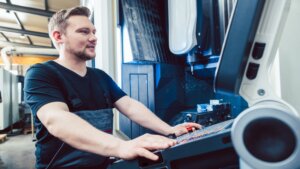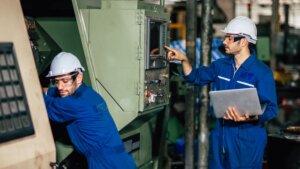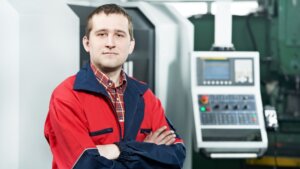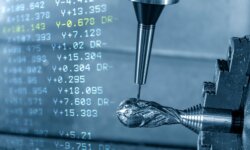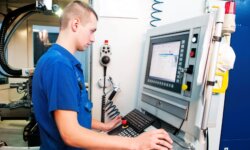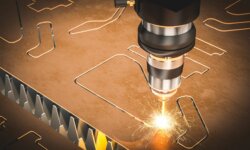In the realm of modern manufacturing, CNC machining emerges not just as a method, but as a monumental shift in production philosophy. This technology, marrying the precision of computer algorithms with the robustness of machine tools, has not just enhanced but redefined the parameters of production.
From its nascent sketches on paper to its current stature as the backbone of manufacturing prowess, we trace the steps of CNC machining’s evolutionary dance, illuminating how it has sculpted the landscape of industry and innovation.
What Is CNC Machining?
CNC machining stands as a pinnacle of modern manufacturing processes, integrating computerized control with traditional machine tools. This advanced form of manufacturing employs computerized systems to govern the movements and operations of machine tools like mills, lathes, and grinders, executing precise and complex cuts that manual operations cannot achieve. CNC technology’s ability to produce intricate parts with exceptional accuracy has made it indispensable in industries ranging from aerospace to medical, transforming the landscape of manufacturing.
The heart of CNC machining lies in its programming. Technicians input detailed instructions into a computer program, often developed using Computer-Aided Design (CAD) software. This program then guides the machine tool, dictating every movement and operation with precision. This innovative approach not only elevates the capabilities of manufacturing but also enhances productivity and efficiency.
Where Did CNC Originate?
CNC machining’s history traces back to the urgent needs of the Second World War. The demand for complex and precise machinery parts, particularly in the aerospace industry, catalyzed the development of this technology. As the war required rapid production of high-quality components, traditional methods proved insufficient, leading innovators to explore automated solutions.
What and how Was the First CNC Machine Ever Made?
The first CNC machine, an experimental milling machine, was born out of a collaboration between John Parsons and Frank L. Stulen at Parsons Corporation in Traverse City, Michigan, in 1952.
Their work centered around producing helicopter blades with a high degree of precision. This early machine laid the groundwork for future development, marking a significant milestone in the history of CNC machining.
Their machine used a motor controlled apparatus and numerical control systems, a nascent form of what we now recognize as CNC technology. It was equipped with a positioning machine tool that could follow points fed into the system on punched tape, a precursor to modern digital programming.
How Did CNC Machining Originate?
The genesis of CNC (Computer Numerical Control) machining can be traced back to the 1940s and 1950s, a period marked by significant technological advancements and a burgeoning manufacturing industry. During this era, the concept of automated machining began to take shape, laying the foundation for what would become a monumental shift in manufacturing processes.
This evolution was driven primarily by the need for greater precision and efficiency in producing complex parts, especially for the aerospace and defense industries during and after World War II.
The development of computer numerical control was a response to the limitations of manual machining and the burgeoning demand for high-precision components. The introduction of motor controlled apparatus and numerical control systems marked a pivotal moment in the history of manufacturing, enabling machines to execute operations based on pre-programmed instructions.
This automation was a quantum leap from the traditional handcrafted techniques that were prevalent before the advent of CNC machines.
Why Was CNC Machining Developed?
The primary motivations for developing CNC machining were the pressing needs of the manufacturing industry for higher efficiency, precision, and the ability to produce complex geometric shapes. During the Second Industrial Revolution, manufacturing processes were undergoing a radical transformation, and CNC technology emerged as a solution to the increasing demands for high-quality parts in industries such as aerospace, automotive, and consumer electronics.
The specific needs that led to the invention of CNC machines included:
- The requirement for mass production of complex parts with tight tolerances.
- The need for consistent quality and precision in manufactured parts.
- Reduction in manual labor and the associated human error in machining processes.
- Increasing demand for faster production rates to meet industry and consumer needs.
Who Were the Pioneers of CNC Machining?
The pioneers of CNC machining were visionaries who foresaw the impact of automated control systems in manufacturing. Key figures include:
- John T. Parsons: Often heralded as the father of CNC machining, Parsons conceptualized the use of numerical control in machine tools. His collaboration with the Massachusetts Institute of Technology (MIT) led to the development of the first numerically controlled machine tools. His work primarily focused on the production of helicopter blades and complex aerospace components, and his contributions have been recognized with numerous awards, including from manufacturing engineers’ societies.
- Frank L. Stulen: Working alongside Parsons, Stulen played a crucial role in refining the concept of numerical control. His technical expertise and innovative thinking were instrumental in the practical application of Parsons’ ideas, leading to the creation of the first prototypes of CNC machines.
Their combined efforts led to the creation of the first CNC machine – an experimental milling machine capable of producing parts with unprecedented precision and complexity. This early machine used punch tape technology, a precursor to modern digital programming, to guide its operations. The success of this project garnered significant attention from the U.S. Air Force, which funded further research and development, accelerating the advancement of CNC technology.
Timeline of CNC machining history

1940s: The Conceptual Beginnings
The 1940s marked the conceptual beginnings of CNC machining. It was a period characterized by the Second Industrial Revolution, where the focus shifted towards automation and efficiency in manufacturing processes.
During this decade, John T. Parsons, an innovative engineer, began conceptualizing the method of numerical control for machine tools. His ideas were revolutionary, laying the groundwork for a new era in manufacturing.
Parsons envisioned a system where the movements of machine tools could be controlled by a series of coded instructions – a radical departure from the manual operation prevalent at the time. This vision was the precursor to modern CNC technology, where computer numerical control allows for precise and automated machining operations.
Late 1940s: Early Experiments
Towards the late 1940s, Parsons’ ideas began taking a tangible form. Collaborating with Frank L. Stulen, they embarked on refining the concept of numerical control. Their experiments were groundbreaking, leading to the development of prototypes that would change the face of manufacturing.
One of their key projects involved developing a method to efficiently produce helicopter blades. This task required precision and repeatability, which traditional machining processes couldn’t achieve.
Their work in this area not only proved the feasibility of numerical control but also highlighted its potential to revolutionize manufacturing capabilities.
Early 1950s: Collaboration with MIT
The early 1950s saw the burgeoning ideas of Parsons and Stulen gain significant momentum. Their work caught the attention of the U.S. Air Force, which recognized the potential of numerical control in improving the manufacturing process of aircraft components. This led to a pivotal collaboration with the Massachusetts Institute of Technology (MIT), a renowned hub of technological innovation.
With the backing of the U.S. Air Force, MIT embarked on a project to further develop and refine the concepts of numerical control. This collaboration was instrumental in transitioning from the theoretical aspects of CNC machining to practical, real-world applications.
It marked a critical phase in the evolution of CNC technology, setting the stage for the development of the first CNC machines.
During this period, the focus was on enhancing the precision and efficiency of manufacturing processes, particularly in the aerospace industry. The partnership between Parsons, Stulen, and MIT was a testament to the transformative power of collaboration in technological advancement.
Their collective efforts were key in establishing the foundations of modern CNC machining, a technology that would soon become integral to manufacturing industries worldwide.
1952: The First NC Machine
In 1952, a significant milestone in the CNC machining history was achieved when the Massachusetts Institute of Technology (MIT) demonstrated the first Numerical Control (NC) machine. This machine, a modified Cincinnati Hydrotel milling machine, represented the culmination of years of research and development in automation and machine tool control. This event is widely regarded as the birth of CNC technology, marking the transition from theoretical concepts to practical, usable technology.
The demonstration showcased the machine’s ability to follow precise instructions coded onto punch tapes, a method that greatly enhanced the precision and complexity of machining operations. This development was a turning point, signaling the potential for widespread application of CNC technology in various manufacturing processes.
1950s: Punch Tape Technology
During the 1950s, punch tape technology became a fundamental aspect of early CNC machines. This technology involved storing data on long strips of paper with punched holes, representing the coded instructions for machine operations. The use of punch tapes enabled CNC machines to perform more complex and precise machining operations than ever before.
Punch tape technology allowed for the storage and retrieval of detailed programming information, paving the way for the development of more advanced CNC systems. It also represented a significant step towards the automation of machining processes, reducing the reliance on manual operation and increasing the efficiency and repeatability of manufacturing tasks.
Late 1950s: Commercialization Begins
Towards the late 1950s, the commercialization of NC machines began, signaling a new era in manufacturing. Companies like the Giddings & Lewis Machine Tool Co. emerged as pioneers in this field, being among the first to sell NC machines commercially. This period marked the beginning of a shift in the manufacturing industry, as more companies started to recognize the advantages of CNC technology.
The commercial availability of NC machines brought about a transformative change in manufacturing capabilities. Industries began to adopt these machines to enhance their production processes, benefitting from increased precision, reduced labor costs, and the ability to produce complex parts with greater ease.
1960s: Introduction of Computer Control
The 1960s witnessed a significant evolution in CNC machining with the introduction of computer control. This transition from Numerical Control (NC) to Computer Numerical Control (CNC) represented a leap in the capabilities of machining technology. Computers began to be used for the control of machine tools, offering enhanced capabilities like real-time feedback and more sophisticated programming options.
This era saw the integration of computer technology into machining processes, enabling more intricate and precise operations. The use of computers allowed for the storage and processing of more complex programs, leading to greater flexibility and efficiency in manufacturing.
1967: First CNC Milling Machine
In 1967, another landmark event occurred in the history of CNC machining – the introduction of the first true CNC milling machine by the Electronic Data Control Company. This advancement significantly expanded the potential of CNC machining, opening up new possibilities for manufacturing complex and intricate parts.
The first CNC milling machine marked a significant improvement over earlier models, incorporating advanced features like computerized programming, precise control of multiple axes, and the ability to perform complex cuts and movements. This machine set the standard for future developments in CNC technology and played a crucial role in its widespread adoption across various industries.
1970s: Microprocessors and Cost Reduction
The 1970s heralded a new era in CNC machining with the advent of microprocessors. These small, yet powerful, components led to the development of smaller, more affordable CNC machines, significantly broadening their accessibility. The impact of microprocessors in CNC technology cannot be overstated; they revolutionized the control systems, making CNC machines more efficient and reliable.
This advancement was particularly beneficial for smaller manufacturing facilities and educational institutions, which previously found the cost and size of CNC machines prohibitive. Microprocessors enabled the production of compact and cost-effective CNC machines, democratizing the technology and fostering a new wave of innovation in various industries.
1980s: Graphical User Interfaces (GUI)
In the 1980s, the development of Graphical User Interfaces (GUIs) further transformed CNC machining. GUIs, aided by advances in personal computing, made CNC machines more user-friendly and approachable. This shift was a significant departure from the earlier, more complex command-line interfaces, which required specialized knowledge and training.
The introduction of GUIs in CNC systems simplified the programming process, making it more intuitive and accessible to a wider range of users. This development not only streamlined the operation of CNC machines but also played a crucial role in expanding their use in different manufacturing sectors.
Late 1980s: Introduction of CAD/CAM
Towards the end of the 1980s, another significant advancement occurred with the integration of Computer-Aided Design (CAD) and Computer-Aided Manufacturing (CAM) into CNC technology. This integration marked a significant leap forward in the efficiency and precision of CNC machining.
CAD/CAM systems allowed designers and engineers to create detailed digital models of parts and components, which could then be directly manufactured using CNC machines. This seamless transition from design to production streamlined the manufacturing process, reducing errors and saving time. The introduction of CAD/CAM systems represented a convergence of design and manufacturing, enhancing the capabilities of CNC machines and enabling more complex and precise production processes.
The integration of CAD/CAM with CNC technology was a pivotal moment in the history of manufacturing, aligning design and production processes more closely than ever before. It paved the way for more sophisticated and automated manufacturing systems, setting the stage for further innovations in CNC machining.
When Did CNC Machining Gain Popularity?
CNC machining began its ascent to prominence in the manufacturing industry primarily in the late 1970s and early 1980s. This period marked a significant shift as industries increasingly recognized the myriad benefits offered by CNC technology. The adoption was gradual but steady, with notable acceleration in the 1990s, as CNC machines became more affordable and user-friendly.
Several factors contributed to this rise in popularity:
- Technological Advancements: The integration of microprocessors and the development of user-friendly interfaces made CNC machines more accessible to a broader range of manufacturers.
- Cost Efficiency: With the reduction in cost due to technological advancements, small and medium-sized enterprises began to invest in CNC technology.
- Increased Demand for Precision: Industries such as aerospace, automotive, and healthcare required components with high precision, which CNC machining could consistently deliver.
- Flexibility and Versatility: CNC machines’ ability to work with a wide range of materials and perform diverse manufacturing processes made them indispensable in many sectors.
Statistics from this era show a substantial increase in the adoption of CNC technology. For instance, in the early 1980s, only a fraction of machine tools were CNC machines, but by the end of the decade, they accounted for a significant portion of all machine tool sales.
What Preceded CNC Machines in Manufacturing?
Before the advent of CNC machines, manufacturing relied heavily on manual machining and traditional machine tools. The predominant methods included:
- Manual Machining: This involved the use of hand-operated tools like lathes, milling machines, and drills. Operators needed high skill levels and experience to produce parts, and the process was time-consuming and prone to errors.
- Mechanical Automation: Some level of automation was achieved through mechanical means, such as cam-driven lathes, but these were limited in flexibility and precision.
- Early Forms of Programmable Machines: The 1950s and 1960s saw the introduction of simple programmable machines, like the NC (Numerical Control) machines, which used punched tape for programming.
These methods, while effective for their time, were limited by their lack of precision, speed, and flexibility compared to what CNC machining would later offer.
How Has CNC Machining Evolved in the 21st Century?
In the 21st century, CNC machining has continued to evolve, driven by continuous advancements in technology, materials, and techniques. Key developments include:
- Integration of Advanced Software: The use of sophisticated CAD/CAM software has become standard, allowing for more intricate designs and streamlined production processes.
- Adoption of IoT and Automation: The integration of the Internet of Things (IoT) and automated systems has led to smarter, more efficient CNC operations.
- Advancements in Materials: The ability to machine a broader range of materials, including advanced composites and superalloys, has expanded the applications of CNC machining.
- High-Precision Machining: Continued improvements in precision and the ability to produce increasingly complex parts have solidified CNC machining’s role in sectors like aerospace and medical devices.
The future of CNC machining is likely to see further integration with technologies like artificial intelligence, augmented reality for training and operation, and continued improvements in speed, precision, and energy efficiency.
Conclusion
Reflecting on the history and impact of CNC machining reveals a remarkable journey of innovation and technological advancement. From its conceptual beginnings in the 1940s to its current status as a cornerstone of modern manufacturing, CNC machining has continuously evolved, shaping the way industries operate and produce.
The impact of CNC machining extends beyond just the manufacturing industry; it has been pivotal in advancing sectors like aerospace, automotive, and healthcare, driving innovation and quality in product development.
FAQs
Who is the father of CNC machining?
John T. Parsons is widely recognized as the father of CNC machining. His pioneering work in the 1940s, conceptualizing the use of numerical control for machine tools, laid the foundation for the development of CNC technology. Parsons’ vision and innovations in machining processes transformed the manufacturing industry, leading to the advanced CNC systems we see today.
When was the first CNC machine patented?
The first CNC machine was patented in 1958 by Richard Kegg, in collaboration with MIT. This groundbreaking invention, a numerically controlled milling machine, represented the transition from manually operated machine tools to automated CNC systems. This patent marked a significant milestone in the history of manufacturing technology, paving the way for the development of modern CNC machining.
